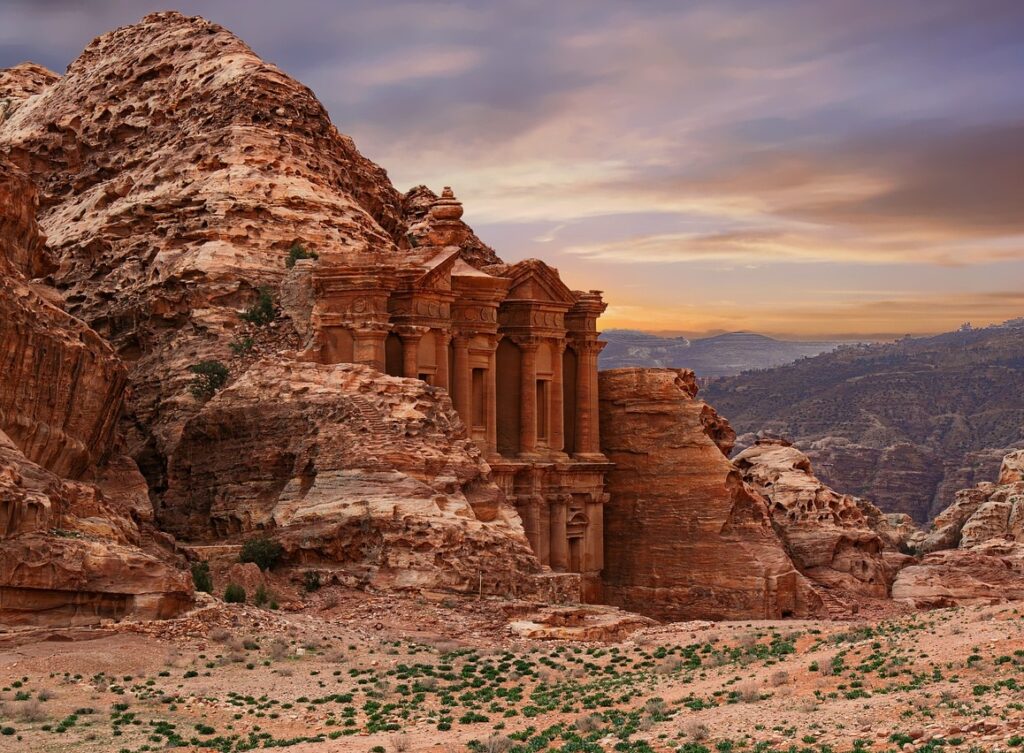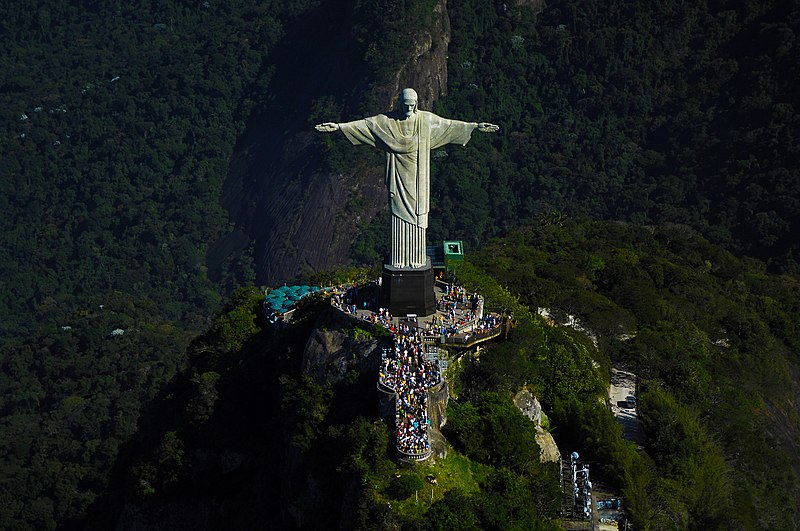Best Time to Visit Petra, Jordan
Post Highlights
- 1 Introduction to Petra
- 2 Petra is Famous For
- 3 Places to Visit and Nearby Attractions of Petra
- 4 Itinerary to Visit Petra and Nearby Places
- 5 How to Reach Petra
- 6 Best Hotels in Petra
- 7 Best Time to Visit Petra
- 8 Local Culture & Cuisine of Petra
- 9 Activities to Do in Petra
- 10 Petra Travel Budget for a Couple
- 11 Petra Reviews of Travelers
- 12 Traveling with Family or Solo to Petra
- 13 Travel Essentials
- 14 Important Instructions
- 15 Safety Travel Tips
- 16 Conclusion
Introduction to Petra
WHERE IS PETRA LOCATED DESTINY 2 – Petra, often referred to as the “Rose City” due to the vibrant hue of its rock-cut architecture, is a symbol of Jordan’s rich history and cultural heritage. Nestled in the southwestern desert of Jordan, this archaeological marvel was once the thriving capital of the Nabataean Kingdom. Petra’s intricate carvings and majestic structures, hidden amidst rugged cliffs and canyons, make it a destination of immense historical and aesthetic significance.
Petra is Famous For
WHERE IS PETRA LOCATED DESTINY 2 –Petra’s fame extends beyond its stunning beauty. It is renowned for:
- Architectural Marvels: The city is home to remarkable structures like Al-Khazneh (The Treasury), Ad Deir (The Monastery), and the Royal Tombs.
- Historical Significance: Petra was an important trading hub for the Nabataeans, who controlled the trade routes between Arabia and the Mediterranean.
- Archaeological Richness: Its blend of Hellenistic architecture with Eastern traditions offers insights into the ancient world’s cultural exchanges.
- UNESCO World Heritage Site: Petra was designated a UNESCO World Heritage Site in 1985, recognizing its outstanding universal value.
Places to Visit and Nearby Attractions of Petra
1. Al-Khazneh (The Treasury)
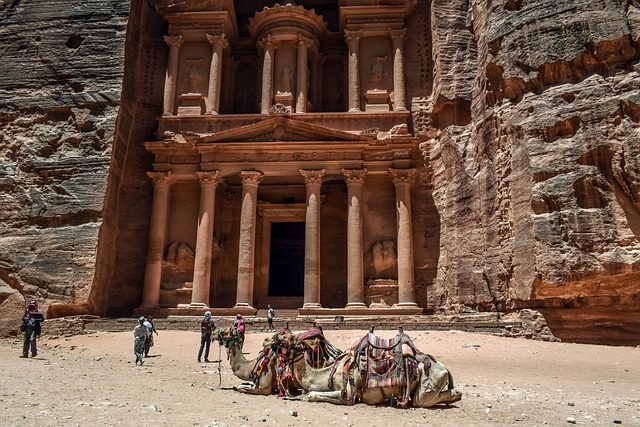
Al-Khazneh, commonly known as The Treasury, is the most iconic structure in Petra. This stunning rock-cut facade stands at approximately 40 meters tall and was originally built as a mausoleum and crypt during the 1st century AD. Its intricate Hellenistic architecture, with a blend of Greek, Egyptian, and Nabataean styles, showcases the grandeur of Petra. The Treasury is located about 1.2 kilometers from the entrance of Petra, accessible through the narrow gorge known as the Siq. This monument is often the first major sight visitors encounter, making it a breathtaking introduction to the ancient city.
2. Siq

The Siq is a natural geological formation and the main entrance to Petra. This narrow, winding gorge stretches for about 1.2 kilometers and varies in width from 3 to 12 meters, with towering cliffs reaching up to 80 meters high. Walking through the Siq is a mesmerizing experience, as the high walls reveal captivating patterns and colors in the rock. The journey through the Siq culminates in a dramatic unveiling of The Treasury, enhancing the anticipation and awe for visitors. The Siq is not just a passageway but a significant part of the Petra experience, steeped in history and natural beauty.
3. Ad Deir (The Monastery)

Ad Deir, known as The Monastery, is one of the largest and most monumental buildings in Petra. It dates back to the mid-1st century AD and is thought to have been a Nabataean tomb. The Monastery is less decorated than The Treasury but is equally impressive due to its grand scale, standing at 50 meters wide and 45 meters high. It is located about 3 kilometers from the city center of Petra and requires a climb of about 800 steps carved into the rock. The hike is rewarding, offering stunning panoramic views of the Petra landscape and surrounding mountains.
4. Royal Tombs
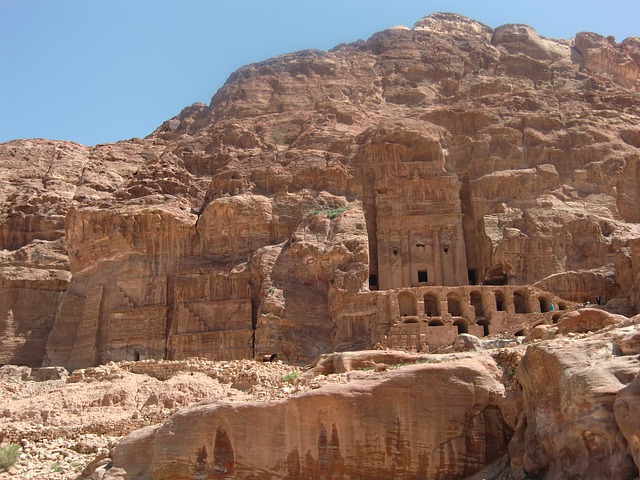
The Royal Tombs of Petra are a series of large and elaborate mausoleums carved into the eastern cliffs of the city. These tombs, believed to belong to Nabataean royalty, include the Urn Tomb, the Silk Tomb, the Corinthian Tomb, and the Palace Tomb. Each tomb showcases unique architectural features and intricate carvings. The Royal Tombs are situated about 1.5 kilometers from the main entrance of Petra and are prominently visible due to their elevated position on the cliff face. Visiting these tombs offers insight into the wealth and artistry of the ancient Nabataeans.
5. Petra Church

The Petra Church, also known as the Byzantine Church, is a significant archaeological site within Petra, dating back to the 5th or 6th century AD. It features well-preserved mosaic floors depicting various animals, humans, and geometric designs, reflecting the artistic skills of its creators. The church complex includes a triple-aisled basilica, baptistery, and several other rooms. It is located about 1.5 kilometers from the entrance of Petra, near the Colonnaded Street. The Petra Church provides a glimpse into the Christian history of the region, showcasing the religious diversity that existed in ancient Petra.
6. Little Petra (Siq al-Barid)

Little Petra, or Siq al-Barid, is a smaller archaeological site located about 8 kilometers north of the main Petra site. This site served as a suburb of Petra and a stopover for caravans. It features similar rock-cut architecture, including temples, tombs, and cisterns, but on a smaller scale. The name “Siq al-Barid” means “Cold Canyon,” reflecting its shaded and cooler environment. Little Petra offers a quieter and less crowded experience, allowing visitors to explore its wonders in a more relaxed setting while gaining insight into the everyday life and trade activities of the Nabataeans.
7. Wadi Rum
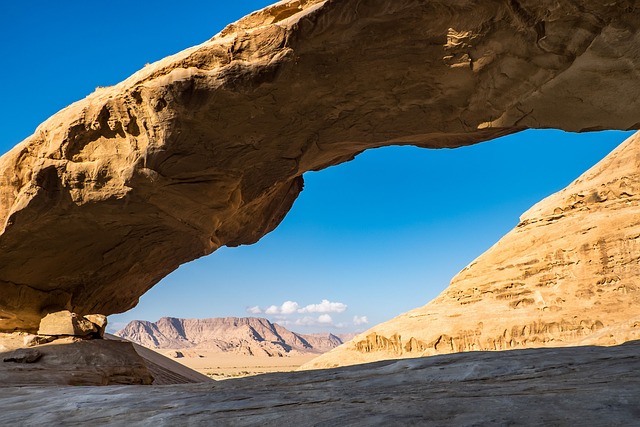
Wadi Rum, also known as the Valley of the Moon, is a protected desert wilderness located about 113 kilometers south of Petra. This stunning landscape is characterized by its dramatic sandstone mountains, vast sandy plains, and ancient petroglyphs. Wadi Rum has been inhabited by various human cultures since prehistoric times, leaving behind a rich tapestry of historical and cultural artifacts. Today, it is a popular destination for hiking, rock climbing, and camel safaris. The natural beauty of Wadi Rum has also been featured in numerous films, making it an iconic symbol of Jordan’s desert scenery.
8. Dana Biosphere Reserve
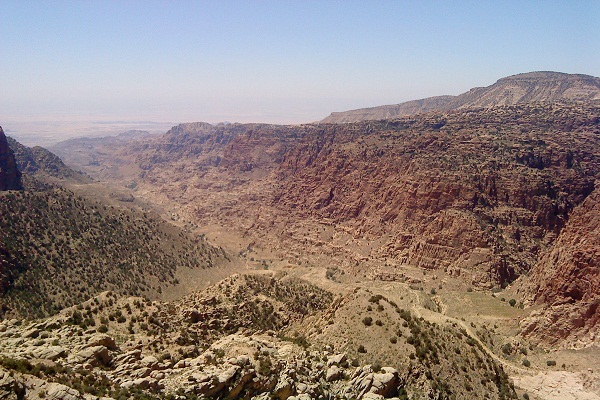
The Dana Biosphere Reserve is Jordan’s largest nature reserve, encompassing about 308 square kilometers of diverse landscapes, from sandstone cliffs to verdant valleys. Located approximately 50 kilometers north of Petra, Dana is home to a wide range of flora and fauna, including several endangered species. The reserve is also rich in archaeological sites, some dating back to 4000 BC. Visitors to Dana can enjoy various outdoor activities such as hiking, bird watching, and experiencing the traditional Bedouin culture. The reserve’s unique ecological and cultural significance makes it a vital part of Jordan’s natural heritage.
Itinerary to Visit Petra and Nearby Places
Day 1: Arrival and Exploration of Petra
- Morning: Arrive at Petra, check into your hotel.
- Afternoon: Visit the Petra Visitor Center and start your journey through the Siq, reaching Al-Khazneh.
- Evening: Explore the Street of Facades and the Royal Tombs.
Day 2: In-Depth Exploration of Petra
- Morning: Hike to Ad Deir (The Monastery).
- Afternoon: Visit Petra Church and explore the Great Temple.
- Evening: Attend Petra by Night for a magical candlelit experience.
Day 3: Little Petra and Surroundings
- Morning: Drive to Little Petra and explore its rock-cut buildings.
- Afternoon: Visit the nearby Neolithic village of Beidha.
- Evening: Return to Petra for dinner and rest.
Day 4: Day Trip to Wadi Rum
- Morning: Drive to Wadi Rum.
- Afternoon: Take a guided jeep tour of the desert, visiting sites like Lawrence’s Spring and Khazali Canyon.
- Evening: Return to Petra or opt for an overnight stay in a Bedouin camp in Wadi Rum.
Day 5: Dana Biosphere Reserve
- Morning: Drive to Dana Biosphere Reserve.
- Afternoon: Enjoy a hike through one of the reserve’s scenic trails.
- Evening: Return to Petra for your final night.
How to Reach Petra
By Air
- Queen Alia International Airport (Amman): The main international gateway, located approximately 235 km (146 miles) from Petra. Regular flights connect Amman with major cities worldwide.
- King Hussein International Airport (Aqaba): Closer to Petra, about 125 km (78 miles) away, serving regional flights.
By Road
- From Amman: A 3-4 hour drive via the Desert Highway (Highway 15) or the more scenic King’s Highway (Highway 35).
- From Aqaba: A 2-hour drive via the Desert Highway.
By Public Transport
- Buses: JETT buses offer daily services from Amman and Aqaba to Petra. Local minibusses also operate but can be less reliable.
Best Hotels in Petra
1. Mövenpick Resort Petra
- Description: Located directly at the entrance to Petra, this luxurious hotel offers spacious rooms, a rooftop terrace, and multiple dining options.
2. Petra Marriott Hotel
- Description: Offering stunning views of the Petra mountains, this hotel provides comfortable rooms, a pool, and a traditional Bedouin tent for evening entertainment.
3. Petra Moon Hotel
- Description: Just a short walk from the Petra Visitor Center, this hotel features modern rooms, a rooftop terrace, and a pool.
4. The Old Village Hotel & Resort
- Description: Set in a restored 19th-century village, this resort combines traditional architecture with modern amenities.
5. Hayat Zaman Hotel & Resort
- Description: A restored Ottoman-era village, offering a unique cultural experience with traditional décor and a tranquil setting.
Best Time to Visit Petra
Spring (March to May)
- Pros: Mild weather, blooming wildflowers.
- Cons: Can be crowded due to peak tourist season.
Autumn (September to November)
- Pros: Pleasant temperatures, fewer tourists compared to spring.
- Cons: Higher accommodation prices during the shoulder season.
Winter (December to February)
- Pros: Fewer tourists, lower prices.
- Cons: Colder temperatures, especially at night, and occasional rain.
Summer (June to August)
- Pros: Least crowded, lower accommodation costs.
- Cons: Extremely hot temperatures, making midday exploration challenging.
Local Culture & Cuisine of Petra
Culture
- Bedouin Heritage: The Bedouins, who have inhabited the Petra region for centuries, add a rich cultural layer with their traditions, stories, and crafts.
- Traditional Music and Dance: Local performances often feature traditional music and dance, providing a glimpse into Jordanian cultural expressions.
Cuisine
- Mansaf: Jordan’s signature dish, featuring lamb simmered in a sauce made from fermented dried yogurt, typically served with rice.
- Maqluba: A flavorful dish of rice, meat, and vegetables, cooked together and flipped before serving.
- Falafel and Hummus: Popular Middle Eastern snacks available at local eateries.
- Zarb: A traditional Bedouin dish cooked underground, involving marinated meat and vegetables.
Activities to Do in Petra
1. Hiking and Trekking
- Explore numerous trails, including the challenging hike to the Monastery or the easier trail to the High Place of Sacrifice.
2. Petra by Night
- Experience the magic of Petra illuminated by thousands of candles, accompanied by traditional music and storytelling.
3. Horseback Riding
- Ride horses through the Siq or around Petra’s periphery, guided by local Bedouins.
4. Photography
- Capture the stunning landscapes and intricate details of Petra’s monuments, especially during the golden hours of sunrise and sunset.
5. Shopping for Souvenirs
- Purchase traditional crafts, jewelry, and souvenirs from local markets and shops around Petra.
Petra Travel Budget for a Couple
Accommodation
- Luxury: $200-300 per night
- Mid-Range: $100-150 per night
- Budget: $50-80 per night
Meals
- High-End Restaurants: $30-50 per meal
- Mid-Range Restaurants: $15-25 per meal
- Street Food and Local Eateries: $5-10 per meal
Entrance Fees
- Petra Entry Ticket: $70 (50 JOD) per person for a one-day pass
- Petra by Night: $24 (17 JOD) per person
Transportation
- Private Car Hire: $50-100 per day
- Public Transport: $5-10 per trip
Total Estimated Budget
- Luxury Trip: $2000-2500 for 5 days
- Mid-Range Trip: $1000-1500 for 5 days
- Budget Trip: $500-800 for 5 days
Note: Prices are approximate and can vary.
Petra Reviews of Travelers
Positive Reviews
- Awe-Inspiring Architecture: Many travelers are captivated by the grandeur and beauty of Petra’s monuments.
- Rich History: Visitors appreciate the deep historical significance and stories behind each structure.
- Friendly Locals: The hospitality and friendliness of the Bedouin guides and local vendors are frequently praised.
Negative Reviews
- Crowds: During peak seasons, the site can become very crowded, detracting from the experience.
- Commercialization: Some travelers feel that the commercialization of the area has somewhat diminished its authenticity.
- High Costs: The entry fees and prices for guided tours and souvenirs are considered high by some visitors.
Traveling with Family or Solo to Petra
Family Travel
- Pros: Educational and enriching experience for children, safe environment, family-friendly hotels.
- Cons: Long walks and hikes can be challenging for young children, limited shade and facilities on site.
Solo Travel
- Pros: Opportunity for personal exploration and reflection, easy to join guided tours and meet other travelers.
- Cons: Need to be cautious about personal safety and secure belongings, potential for higher costs without shared expenses.
Travel Essentials
Clothing
- Comfortable walking shoes
- Lightweight, breathable clothing
- Hat and sunglasses for sun protection
- Warm layers for cooler evenings
Gear
- Camera with extra batteries
- Water bottle
- Sunscreen
- First aid kit
Documents
- Passport with visa (if required)
- Travel insurance
- Copies of important documents
Important Instructions
- Respect the Site: Do not climb on monuments or remove any stones or artifacts.
- Stay Hydrated: Carry plenty of water, especially during hot weather.
- Follow Local Guidelines: Adhere to any instructions given by local guides or authorities.
Safety Travel Tips
- Stay with a Group: Avoid wandering off alone, especially in less populated areas.
- Beware of Scams: Be cautious of offers that seem too good to be true, such as cheap tours or souvenirs.
- Health Precautions: Be mindful of food and water hygiene to avoid stomach issues.
Conclusion
Petra is not just a destination; it’s an experience that transports you back in time to an era of remarkable craftsmanship and cultural fusion. Whether you’re an avid historian, an adventure seeker, or simply a traveler looking to witness one of the world’s most impressive sites, Petra offers something for everyone. With careful planning and a sense of adventure, your journey to Petra can be a memorable and enriching experience. Embrace the beauty, history, and culture of this ancient city, and let Petra’s timeless charm leave an indelible mark on your heart.

